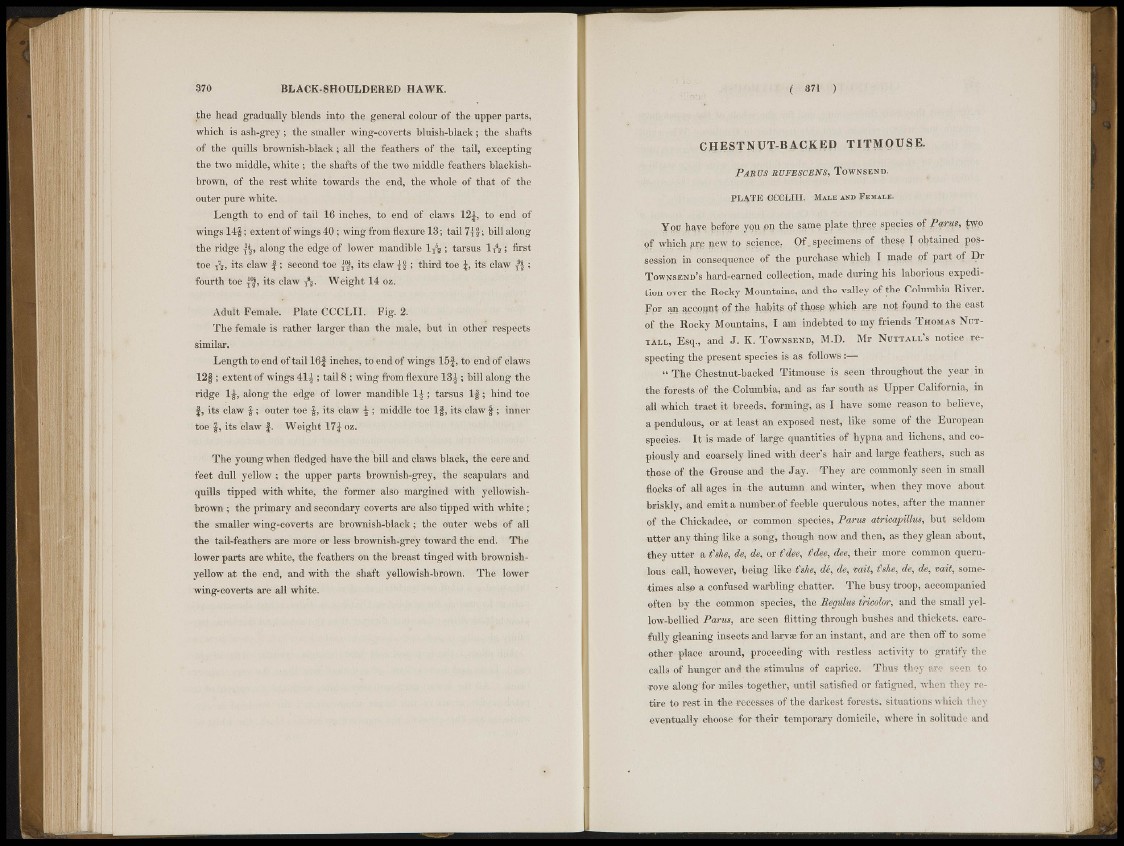
370 BLACK-gHOHI<DERED HAWK.
the head gradually blends into the general colour of the upper parts,
which is ash-grey ; the smaller wing-coverts bluish-black ; the shafts
of the quills brownish-black ; all the feathers of the tail, excepting
the two middle, white ; the shafts of the two middle feathers blackishbrown,
of the rest white towards the end, the whole of that of thè:
outer purè white.
Length to end of tail 16 inches, to end of claws 12^, to end of
wings-14|; extent of wings 40 ; wing from flexure 13; tail 711; billalong
the ridge along the edge of lower mandible 1 ¡^ ; tarsus 1 ; first
toe its claw f ; second toe its claw ; third toe J, its claw ;
fourth toe its elaw Weight 14 oz.
Adult Female. Plate CCCLII. Pig. 2.
The female is rather larger than the male, but in other respects
similar.
Length to end' of tail lGf inches, to end of wings 15f, to end of claws
12f ; extent of wings 4 1 | ; tail 8 ; wing from flexure ; bill along the
ridge 1^, along the edge of lower mandible ; tarsus If ; hind toe
f , its claw I ; outer toe f , its claw ij ; middle toe I f , its claw f ; inner
toe J, its claw J. Weight 17 J oz.
The young when fledged have thè bill and claws black, thè cere and
feet dull 'yellow ; the upper parts 'brownish-grey, the scapulars and
quills tipped with white, the former also margined with yellowishbrown
; the primary and secondary coverts axe also tipped with white ;
the smaller wing-coyerts are brownish-black ; the outer Webs of all
the tail-feathers are more or less brownish-grey toward the end. The
lower parts are white, the feathers on the breast tinged with brownishyellow
at the end, and with the shaft yellowish-brown. The lower
wing-coverts are •all white.
( «71
C l I E S T N U T - B A C K K O TITMOUSK.
PA HITS HUFESCENS, Townsend.
PLATE G(;ej,IlI. Mali akd Female.
Yojj ha,ye before ygu pn the same plate three species of P<vnis, f f f p
qf which ¡irg now ft> scionci!; Of. specimens of those I «Ijtiiinmi possession
in consequence of the purchase which I made .of part of Dr
Towxsknd's hard-earned collection, made during his laborious expedition
over the Rocky Mountains, and the valley of the Columbia River.
f i a w f m m t pf th» habits sf those whwfe m not ftwd to A«.e a s t
of the Rocky Mountains, I am indebted-to my friends Thomas Npttai.
i., Ksq., and J. K. Townsend, M.I). Mr Ncttali/s notice:respecting
the present species is as follows:—
" The ehestmit-lrai'kod Titmouse & seen throughout the year in
tlie fonwts of tile Columbia, ¡mil as far south ¡as Upper California, in
all which tract it breeds, forming, as I have gome reason to believe,
a .pendulous, or at least an exposed west, like some of the European
speeies- It is made of ¡large quantities of hypna and lichens, and copiously
and coarsely lined with deer's hair and large feathers, such as
•those of the ©rouse and the Jay. They are commonly seen in small
flocks of all ages in the autumn and winter, when they move about
briskly,,and emit a mimberiof feeble ¿querulous notes, after the manner
of the Chickadee* or common, species, Paras atricapillm, but seldom
•utter any tiling 'like a song?,',though now and then, as they glean about,
they fitter a fshe, de, dei or fdee, tfdee, dee, their more common querulous
call, fcowever, being like fshe, de, de, 'cait, i'ske, de, de, 'Gait, sometimes
also a confused warbling chatter. The busy troop, accompanied
often by the common species, the Regulus tricolor, and the small yellow
bellied Pans, are seen flitting through bushes and thickets, carefully
gleaning inseets audlarv® for an instant, and are then off to some
o t t e r place «¡round, proceeding with restless activity to gratify the
calls of hunger and the stimulus of caprice. Thus they are seen to
®oy,e along for miles together, until satisfied or fatigued, when they retire
to rest in the recesses of the darkest forests, situations which they
e-venttially «feoose for tiheir temporary domicile, where in solitude and